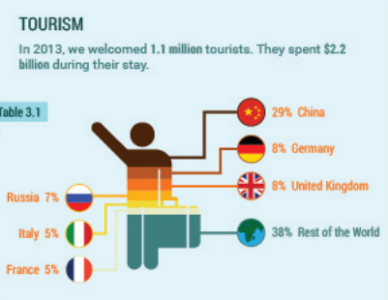Tourist arrivals in the first three quarters of 2014 registered a 10.1 percent growth compared to the same period last year, reaching a total of 901,004 guests by the end of September, the Ministry of Tourism has revealed.
Visitors from Asia and Pacific countries accounted for 50 percent of all arrivals during the first nine months of the year.
However, the ministry noted in a statement last week that “the pace at which arrival from the region was increasing have slowed down since June.”
“While the region enjoyed a robust growth of 22.3 percent at the end of first two quarters of 2014, growth rate slowed down to 17.3 percent by the end of the third quarter of 2014,” the ministry explained.
“The region injected 53,454 tourists to the total arrivals to the country during the month of September, summing up the total arrivals from the region to 450,296 by the end of the period from January to September 2014.”
China (31.8 percent), India (3.5 percent), Japan (3.1 percent) and South Korea (2.7 percent) were the leading markets from Asia and the Pacific region, the ministry revealed, with Australia (1.6 percent) “emerging as a potential market from this region.”
“The Chinese market, registered a negative growth (-1.7 percent) for the first time in September 2014 since becoming the number one market in 2010. However, the market ended up with a healthy 14.8 percent growth at the end of the period from January to September 2014 with a total of 286,838 tourists.”
Tourist arrivals from Europe meanwhile increased 1.6 percent in the first three quarters compared to the same period in 2013, reaching 386,914 visitors.
“In terms of individual markets from Europe, leading markets were Germany (7.7 percent), the United Kingdom (7.4 percent), Russia (5.7 percent), Italy (4.8 percent) and France (4.2 percent),” the ministry revealed.
Arrivals from the Americas registered a strong growth of 25.2 percent in September with double digit growth rates recorded from all major markets in the region.
“With just a couple of hundred tourists less than that of Americas, Middle East followed closely behind bringing in a total of 28,641 tourists at the end of the period from January to September 2014 accounting for 3.2 percent of all arrivals during the period,” the ministry noted.
“This region also posted a heavy growth of 20.5 percent during the month of September 2014 ending the period with a robust 16.9 percent growth.”
Meanwhile, one new resort – Loama Resort Maldives on the island of Maamigili in Raa Atoll – and seven new guest houses opened during September.
“With these new additions, the total number of registered establishments reached 488 with 30,893 beds at the end of September 2014,” the ministry noted.
“While the total number of registered resorts increased to 112 with 23,917 beds and guest houses increased to 195 with 2,723 beds, number of hotels and safari vessels remained at 18 and 163 with 1,542 beds and 2,711 beds respectively by the end of September 2014. At the end of this period on average there were 292 establishment with 26,905 beds in operation.”
Statistics show that total bednights during the period was 5.4 million, with an average occupancy rate of 74.6 percent – an increase of 1.6 percent compared with the same period in 2013. Average duration of stay remained steady throughout the January to September period.
Quarterly economic bulletin
The Maldives Monetary Authority’s (MMA) quarterly economic bulletin released last week meanwhile observed that the “favourable growth in the tourism industry during the year suggests that the arrival of a million tourists during one calendar year is likely to be achieved in 2014 as well.”
“Reflecting the growth in bed nights, total tourism receipts grew by an annual 12 percent during the first six months of 2014 and totalled US$1.3 billion,” the central bank revealed.
While the market share of Europe fell from 51 percent in the first half of 2013 to 47 percent in the same period this year, the MMA noted that arrivals from Germany and the UK increased.
“In particular, the sustained growth of arrivals from UK, with a market share equivalent to 8 percent, reflects its economic revival to pre-crisis levels,” the bulletin suggested.
“Other markets in Europe, however, indicated sluggish or negative growth in tourist arrivals, contributing to the overall marginal increase in arrivals from Europe.”
The MMA also observed that in the past five years “the development of guesthouses as a low cost accommodation option for tourists in local inhabited islands has gained significant momentum.”
The authority noted that the number of guest houses in the industry is now over 2,400
“As at the end of June 2014, the number of registered beds in the [guest house] industry is recorded to be over 2,400. While the bed capacity of guesthouses accounted for a mere 2 percent of the bed capacity of the industry as a whole in 2010, it has now come to represent 8 percent of the total bed capacity in tourism establishments,” the bulletin stated.
